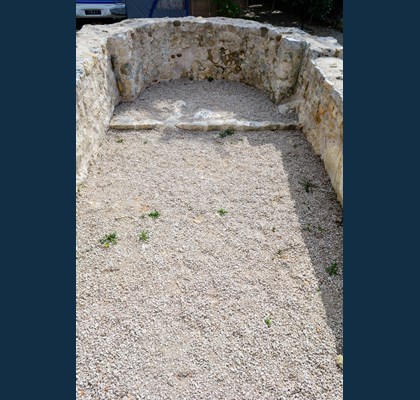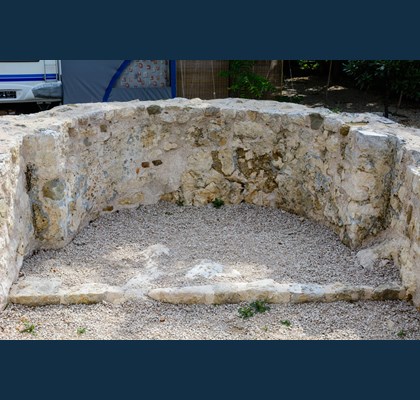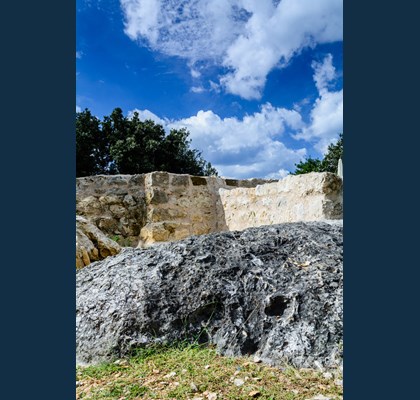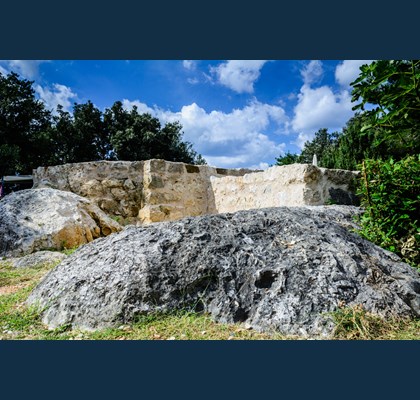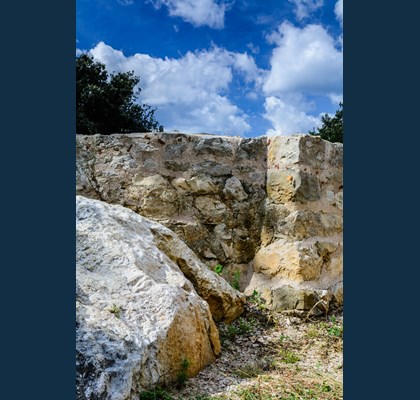Style period: romanesque
Century: 12
A.D.
One of the many churches and chapels in the Krk surroundings, which were lost, is the church of St Mary of the Spring, or Santa Maria Dell’Aqua. Its remains can be found on the site Lunta in the western periphery of Krk, in the zone of the Camp Ježevac. Until now, little was known about the church. It is mentioned in merely a few sentences in all bibliography, describing it only as a partially preserved church with traces of an apse, which is older than the sources say. The church was first mentioned in 1486, which proves the time of its existence, but not the time of its emergence.
Archaeological study has shown that this was a one-nave church with a shallow apse, protruding outside on the eastern side. The area of the presbiterium was one step higher in relation to the church hall and it was separated by a stone partition – the septum. The remains of the walls show meticulous mastership of a medieval structure, where each stone is carefully cut and put into regular layers. There are still visible traces of fine plastering on the walls, in two layers, which indicates the church was restored. The northern apse shoulder has a trace of a red line, which is proof, however small, of fresco painting that adorned the church walls.
The way of building and all architectural elements indicate that it was built in the Romanesque period. Still, the findings of stone plastics suggest an earlier period.
An interesting finding was discovered to the west of the structure, to the north of the apse. During clearing of a solid rock, rising about 50 cm off the ground level, a deep pit was discovered within the rock, which may have been a natural spring. There are traces of cutting on the rock, which shows that through human activity this inaccessible natural formation was adapted into a usable source of water. The rock is shaped as a horse-shoe and has a stone step facilitating the approach to water. The entire area of the Camp Ježevac is rich in underground waters which disappear up to a metre and a half under ground, and in this place the water found its way to the surface.
This suggests the conclusion that the well – spring is the reason why the church was located in the area and why the toponym carries the name Sancta Maria Delle Aque, or Saint Mary of the Spring. The spring is intentionally fitted into the architecture. There are still legends about the medicinal properties of the water in the now dry springs in this area.
There is a legend in the local tradition, recorded in about 1500, which mentions the arrival of St Francis and his brothers to the island of Krk, who found shelter from the upcoming storm in the harbour near the church of the Mother of God. According to the legend, they found a hermit there and taught him the rules of their order. Allegedly this was the origin of the establishment of the Franciscan order in Krk.
The church is a valuable monument of early medieval church architecture in the area of Krk. An archaeological research has recently been conducted on the object and its immediate surroundings, which was accompanied by conservation of the walls in order to prevent the decay of the object.
Bibliography:
- Bolonić, Mihovil, Žic-Rokov, Ivan, Otok Krk kroz vjekove, Kršćanska sadašnjost, Zagreb, 1977.
- Makarun, Matija, Izvještaj arheoloških istraživanja s lokaliteta Sv. Marija od Izvora u kampu Ježevac, 2012.

